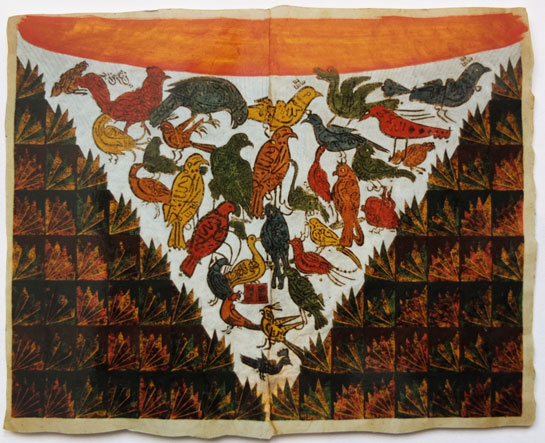Selected Works from 1990s

Graham Day: Selected works from the 1990s
Rose Issa Projects, 14-29 August 2014
To see a Video ‘Artist Graham Day guides us through a decade of his creative journey, giving us an insight into his sources of inspiration, techniques and themes that recur in his work.’ click on this link.
Click here to see more images
Since graduating from University College London in 1973, Graham Day has continually explored and experimented with an eclectic mix of themes and techniques. This selection of his work made during the 1990s derives from Sufi poetry, mathematical paradox, Tantric Yantras, Chinese jade, Greek mythology, and Mannerist polyhedra. His techniques include paper making, integral paper marbling, gilding, and monoprinting as well as traditional painting, collage and modelling. His often literary starting points reveal a search for the origins of form common to us all.
This solo exhibition is the third in a series of decade-by-decade retrospectives of his work. In the text below, Day explains his creative process and the ideas behind the pieces selected for the exhibition.
Colouring in the Nineties
“The beginning of the decade found me cutting woodblocks of Arabic zoomorphic images of birds, where the image is composed from calligraphy. I used these woodblocks to illustrate the 12th-century epic, The Conference of the Birds, by the Persian Sufi poet Farid ud-Din Attar. In this well-known tale, the birds of the world (who represent human archetypes) embark on a perilous journey over seven valleys in search of their king, the legendary Simorgh. By the time they reach their destination, only thirty birds survive (in Persian, Si means thirty and Murgh means birds). They come face to face with the object of their quest – an image of themselves reflected in a lake. For this series I used monoprinting, manipulating the blocks like large rubber stamps onto wobbly Indian paper. Printing inevitably involves reversed images and symmetry, which seemed appropriate for the story.
Around this time I also made a picture, One-way Ticket, which is an illustration of Sierpinski’s Theorem. This mathematical paradox states that a cube of finite volume can have a potentially infinite surface. To me, this seems an ideal concept to illustrate life. I made the picture as if it was a page from an imaginary register, the squares consecutively numbered, each representing a unique entity. I used paper brought from China by a missionary in the 1920s, adding areas of gilding, marbling and burning to represent birth, life, and death. Another small picture presented “Gematria”, the Arabic system of equating letters and numbers. I combined the information in a spiral that allowed meaningful juxtapositions.
Some time later in a bookshop I chanced upon The Illustrated Bartsch, a catalogue of Old Master prints. I was particularly struck by the 16th-century Swiss artist Jost Amman’s engravings for the German goldsmith Wenzel Jamnitzer, especially the Perspectiva Corporum Regularium – spectacular variations on the five Platonic Solids. I transcribed these onto antique English paper and then paper-marbled the 120 forms, surrounding each page with an entwined, gilded lattice. I made numerous other pictures of these five essential shapes (each with the same volume), built cardboard models, and photographed them, using the gum bichromate technique (a 19th-century photographic printing process) to print them. I then overworked them with gold and floated them in a sea of Japanese suminagashi marbling.
Other sequential works with literary starting points include a set of the Hindu tantric meditative forms known as the Tattwas. I painted these on paper that I repulped from a battered 18th-century copy of the life and works of Horace Walpole, which I found in a gutter in Charing Cross Road.
The mid-1990s found me photographing hundreds of London’s Victorian coal hole covers, those decorated metal discs we see set into old stone pavements, which were lifted to allow coal to be tipped into the coal cellars of big houses. To me they resemble Indian Yantras, contemplative diagrams with mostly triangular and square motifs. The designs on the coal covers had no symbolic meaning – they were merely to stop people slipping on smooth metal – yet their purpose as a portal to a fiery world resonates with how Yantras are used. Considering the simple diagrams and cross-cultural connections led me to compile a compendium of basic shapes that could be recognised and understood by all cultures, a nod to Owen Jones’ famous work from 1856, The Grammar of Ornament. I presented mine as votive icons, as irreducible as the Tattwas and Platonic Shapes. The most well-known and revered of all the Indian Yantras is the Sri Chakra or Auspicious Circle, composed of nine interlocking triangles that radiate outwards from a central point. I have been analysing its geometry for 40 years and in the mid-Nineties I made a work that demonstrated a method to accurately construct a Sri Chakra, starting with a blank square and progressively cutting the lines and taking a rubbing, the result being the finished form and how it got there.
In 1997 I made a work about the people in my life. The Moons of Jupiter combined images of Chinese Bi discs, the enigmatic jade discs that are found in Neolithic burial sites. Their purpose is unknown and the absence of any figurative imagery leaves their interpretation open to question. Beneath each of the 16 disc images I wrote in gilded Latin capitals the names of the moons of Jupiter, which are all female characters from Greek mythology. Beneath the gold I wrote the names of friends in silver cursive script. I arranged the 16 sheets into the magic square of Jupiter, where the numbers in each row, column and diagonal add up to 34.
The decade ended as it had begun, working on a new series of paintings derived from stanzas of The Conference of the Birds that I had not considered the first time, such as “Give up the Intellect and see, in one brief moment, all Eternity”.
Graham Day
London, summer 2014












